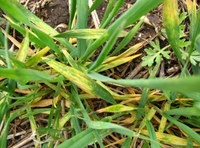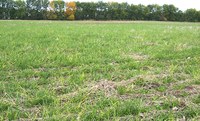Now Is the Time to Manage Wheat Streak Mosaic
(Click an image below to view a high-resolution image that can be downloaded)
Wheat streak mosaic virus (WSMV) was severe in a number of wheat fields in North Dakota this year. The virus was confirmed in 71 wheat samples sent to the North Dakota State University Plant Diagnostic Lab. A majority of these samples came from counties in the north-central region of the state.
Keys to managing this disease include understanding its life cycle and directing steps to break the cycle.
WSMV causes yellowing and mosaic streaking of the leaves, stunting of the plant and potentially large yield losses. The virus is transmitted from plant to plant by the tiny wheat curl mite. This mite, only 1/100 inch in length, needs a green bridge to live, reproduce and survive. The mite can feed, transmit the virus, lay eggs and complete its cycle in seven to 10 days under warm temperatures of 70 degrees or more.
Starting with one mite, a population of 3 million mites could be produced within 60 days. These virus-transmitting mites move from plant to plant by wind. Although mites can be spread a distance of greater than one mile, severely infected fields generally are found within one-half mile of the source field. Insecticides or miticides will not control wheat curl mites. A few wheat varieties have some levels of resistance to the mite or virus.
The most favored hosts for the mites are all the wheat crops (winter, spring or durum). Grassy weeds, such as Downy brome and smooth crabgrass, are good hosts, while corn, cheat and Japanese brome are fair hosts. Barley, rye and foxtails are poor hosts for the mite but have been known to be infected with the virus. Mites will feed on corn kernels and can move from green corn into adjacent winter wheat crops.
“The wheat streak mosaic disease is managed by breaking the life cycle of the mite through cultural practices,” says Marcia McMullen, NDSU Extension Service plant pathologist. “First, producers need to control volunteer wheat and grassy weeds at least two weeks prior to planting. Producers also need to use appropriate planting dates.”
Prior to planting winter wheat this fall, the field to be planted and adjacent fields should be free of any wheat volunteers or grassy weeds.
“This is generally accomplished with burn-down herbicides applied at least two weeks prior to planting to assure complete weed control prior to the emergence of the new wheat crop,” says Dan Waldstein, NDSU Extension area specialist at the North Central Research Extension Center in Minot. “If no host is available in the field, the mite will die. The second step, which is the date of planting, also is very important. Planting winter wheat too early in the fall generally results in the emergence of the crop while the mites still are very active because of warm temperatures. Generally, NDSU recommends planting winter wheat in northern-tier counties within the first two weeks of September and the last two weeks of September in the more southern counties.”
No volunteer winter wheat should be left standing through the winter as a potential crop.
WSMV was severe this year because the late harvest made it difficult for producers to kill volunteers and weed hosts with herbicides a solid two weeks prior to planting winter wheat in 2009. Early planted winter wheat emerged in September when warm weather caused higher mite activity. Winter wheat planted at the end of September or later emerged in October, which was considerably colder than September and led to decreased mite activity and less spread of the virus.
Also, the abundant snow cover during the winter had two adverse consequences. It allowed the wheat curl mite and infected spring wheat to survive better and further spread the disease. Producers in high-risk areas did get some relief in May as cooler temperatures allowed the wheat to grow faster than the mite populations.
NDSU Agriculture Communication
| Source: | Marcia McMullen, (701) 231-7627, marcia.mcmullen@ndsu.edu |
|---|---|
| Source: | Dan Waldstein, (701) 857-7682, daniel.waldstein@ndsu.edu |
| Editor: | Rich Mattern, (701) 231-6136, richard.mattern@ndsu.edu |



